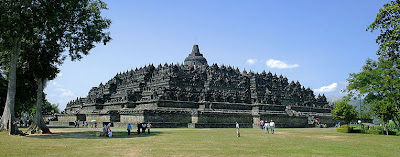BOROBUDUR TEMPLE INDONESIA - Borobudur is the largest Buddhist temple in the 9th century measuring 123 x 123 meters. This Buddhist temple has 1460 relief panels and 504 Buddha effigies in its complex. Borobudur was built by King Samaratungga, one of the king of the ancient Mataram kingdom, descendant dynasty dynasty. Based on Kayumwungan inscription, an Indonesian named Hudaya Kandahjaya revealed that Borobudur is a place of worship that was completed on 26 May 824, almost one hundred years since the beginning of construction. Borobudur own name according to some people means a mountain having terraces (budhara), while the other says that Borobudur means monastery on the heights.
Borobudur building punden shaped staircase consists of 10 levels. Height of 42 meters and 34.5 meters before being renovated after the renovation because the lowest level is used as a buffer. Six levels of a square bottom and upper three circular form, and the highest level of Buddhist stupa facing to the west. Each level represents the stages of human life. Appropriate school of Mahayana Buddhism, anyone who wants to reach the level of the Buddha had to go through each level of the life.
The base of Borobudur, called Kamadhatu, symbolizing human beings that are still bound by lust. Four levels above referred Rupadhatu symbolizes man who has been able to break free from lust, but still tied to appearance and shape. At these levels, a statue of Buddha laid open. Meanwhile, three levels above where Buddha placed inside perforated stupa called Arupadhatu, symbolizing man who was freed from lust, appearance, and shape. The top part is called Arupa symbolizes nirvana, where Buddha is residing.
Each level has a beautiful reliefs that show how skillful. Relief that will be read coherently when you walk in a clockwise direction (towards the left of the entrance of the temple). At Borobudur reliefs tells the story of a legendary story, the Ramayana. In addition, there are relief panels depicting the condition of society at that time. For example, the relief of farmers' activity reflecting the advance of agriculture system and relief of sailing boat representing the advance of the cruise, who was based in Bergotta (Semarang).
All relief panels in Borobudur temple reflect Buddha's teachings. Therefore, this temple functions as educating medium for those who want to learn Buddhism. YogYES invites you to surround each of the narrow alleys in order to understand the Borobudur Buddhist philosophy. Atisha, a Buddhist from India in the 10th century, had been to the temple which was built three centuries before Angkor Wat in Cambodia and 4 centuries before the Great Cathedral in Europe.
All relief panels in Borobudur temple reflect Buddha's teachings. Therefore, this temple functions as educating medium for those who want to learn Buddhism. YogYES invites you to surround each of the narrow alleys in order to understand the Borobudur Buddhist philosophy. Atisha, a Buddhist from India in the 10th century, had been to the temple which was built three centuries before Angkor Wat in Cambodia and 4 centuries before the Great Cathedral in Europe.


No comments:
Post a Comment